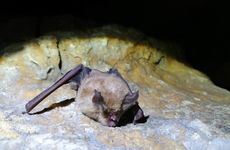
NEW YORK – A team led by investigators in Thailand and Singapore has tracked down SARS-CoV-2-related coronaviruses, dubbed SC2r-CoVs, in bats from a cave in Thailand, highlighting the broad distribution and genetic diversity of potential progenitor viruses.
"Although the origin of the virus remains unresolved, our study extended the geographic distribution of SC2r-CoVs from Japan and China to Thailand over a 4,800-km range," co-senior authors Lin-Fa Wang and Thiravat Hemachudha, researchers with Chulalongkorn University's Thai Red Cross Emerging Infectious Diseases Health Science Centre, and their co-authors wrote in Nature Communications on Tuesday.
Starting with surveillance screening for SARS-related coronaviruses in rectal swab or blood samples from 100 Acuminatus horseshoe bats (Rhinolophus acuminatus) in Thailand and 10 pangolins at wildlife checkpoints in the country, Wang, Hemachudha, and their colleagues identified SC2r-CoV isolates in five bats from a wildlife sanctuary in eastern Thailand. Their subsequent whole-genome sequencing and phylogenetic analyses suggested that the Thai bats carried SC2r-CoVs with genetic ties to a viral isolate known as RmYN02 detected in R. malayanus bats from Yunnan in China.
"[T]he current study provides further experimental evidence to support the notion that the distribution of SC2r-CoVs is not limited to China," the authors reported. "Southeast Asia, due to its richness in both relevant bat species diversity and population density, may be more likely to be a hotspot for such viruses."
Using serological testing, meanwhile, the team detected SARS-CoV-2 neutralizing antibodies with activity against the receptor binding domain of SARS-CoV-2 in wild animals in Thailand — not only in R. acuminatus bats from the Thai cave, but also in at least one Malayan pangolin (Manis javanica) tested at a wildlife checkpoint station in southern Thailand.
The results are consistent with the notion that pangolins are prone to infection with viruses resembling SARS-CoV-2 or SARS-CoV. Indeed, prior studies have pointed to SARS-CoV-related viruses in bats and pangolins as clues to the potential reservoir for the virus behind the COVID-19 pandemic.
Even so, the authors of the current study cautioned that their work "is unable to differentiate the role of pangolins as a spillover host from a secondary reservoir host."
"Further investigation with more systemic and longitudinal sampling of animals in their natural habitat is required to better understand the role of pangolins in transmitting and/or maintaining [SARS-related coronaviruses]," the authors wrote, concluding that "rich diversity of SC2r-CoVs in the region suggests that there is a high probability to find the immediate progenitor virus of SARS-CoV-2 with intensified and internationally coordinated surveillance."
